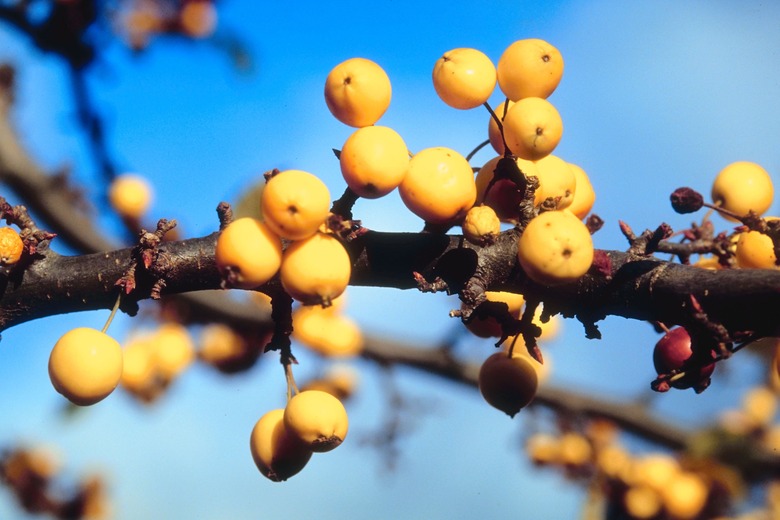Ten Plants With Yellow Berries
Plants that produce yellow berries add a splash of bright color to the landscape. Many also attract wildlife and provide food and habitat for beneficial pollinating species. Berry-producing plants vary widely in form, size and cultural requirements. When choosing species for your landscape, consider factors such as sun and soil preferences and plants' mature height and width. Certain yellow berries are toxic if ingested.
Step 1
The American holly (Ilex opaca), an evergreen tree, grows to 50 feet tall. Several cultivars produce yellow berries, including "Calloway," "Canary," "Morgan Gold" and "Xanthocarpa." American hollies grow best in sun to partial shade.
Step 2
Dahoon Holly
Step 1
The dahoon holly (Ilex cassine), an evergreen tree that grows to 30 feet tall, produces clusters of berries. Yellow-fruiting cultivars include "Bryanii" and "Tryon Palace." They prefer sun to partial shade.
Step 2
Saw Palmetto
Step 1
The saw palmetto (Serenoa repens), a palm shrub that grows to 10 feet tall, produces yellow berries in late summer that turn black over time. This shrub has fan-shaped foliage and tolerates drought and salt.
Lignumvitae
Step 1
The lignumvitae (Guaiacum sanctum), a broadleaved evergreen tree, grows from 12 to 40 feet tall. Its dark-blue flowers bloom throughout the year and are accompanied by yellow, heart-shaped berries. It grows well in full sun to partial shade and tolerates a range of soils.
Step 2
- The American holly (Ilex opaca), an evergreen tree, grows to 50 feet tall.
- The saw palmetto (Serenoa repens), a palm shrub that grows to 10 feet tall, produces yellow berries in late summer that turn black over time.
Locust Berry
Step 1
The locust berry (Byrsonima lucida), a small tree or large shrub, blooms with white, pink and yellow flowers, followed by wildlife-attracting yellow berries. It grows from 3 to 30 feet tall and can be grown as a hedge.
Yaupon Holly
Step 1
The yaupon holly (Ilex vomitoria) grows as a 25-foot-tall small tree or large shrub. Several cultivars of this evergreen produce yellow berries, including "Aureo," "Otis Miley" and "Wiggins." They prefer sun to partial shade and tolerate a variety of soils.
Step 2
White Berry Nandina
Step 1
The white berry nandina (Nandina domestica "Alba"), an evergreen shrub, produces creamy white to yellow berries in fall. It grows from 4 to 6 feet tall with a similar spread. Nandinas prefer sun to partial shade and moist, well-drained soil.
Step 2
- The locust berry (Byrsonima lucida), a small tree or large shrub, blooms with white, pink and yellow flowers, followed by wildlife-attracting yellow berries.
D’Or Chinese Holly
Step 1
The D'Or Chinese holly (Ilex cornuta "D'Or") produces clusters of bright yellow berries. This evergreen shrub grows to 15 feet tall and has glossy, spiny foliage. D'Or Chinese hollies prefer sun to light shade and grow in a range of soils, from clay to sand.
Horse Nettle
Step 1
The horse nettle (Solanum carolinense), a perennial flowers, blooms with white to purple flowers from summer through fall. Its yellow berries are toxic if ingested in large quantities. Horse nettles grow to 4 feet tall and prefer sandy soil.
Berries Jubilee Honeysuckle
Step 1
Berries Jubilee honeysuckle (Lonicera periclymenum), a deciduous vine, produces yellow berries. This 20-foot-vine blooms with fragrant white flowers. It prefers sun to light shade .
Step 2
- The D'Or Chinese holly (Ilex cornuta "D'Or") produces clusters of bright yellow berries.
- D'Or Chinese hollies prefer sun to light shade and grow in a range of soils, from clay to sand.
